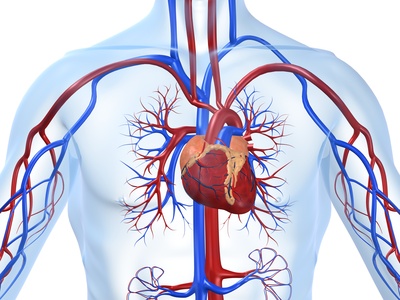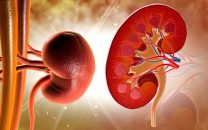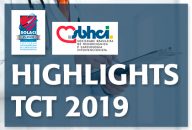The incidence of peri-procedural transcatheter heart valve embolization and migration (TVEM) is as low as 1%. However, it is associated with increased morbidity and mortality. Peri-procedural TVEM is one of the most feared complication given its potential to transform the procedure into a catastrophe, but little do we know about its incidence (except for a…
Trying to Reduce Post TAVR Kidney Injury
Acute kidney injury is a common complication after transcatheter aortic valve replacement (TAVR) and is associated to increased mortality both short and long-term. In patients undergoing percutaneous coronary intervention (PCI) forcing diuresis with controlled hydration has shown to reduce the incidence of acute kidney injury in nearly 50%. However, this has not been tested in…
More Evidence on Tricuspid Valve Repair
While still lacking large-scale randomized trials, evidence is slowly building for transcatheter tricuspid valve repair. This work, presented at the TCT 2019 Congress and simultaneously published in JACC, shows that transcatheter tricuspid valve repair is not only feasible, but also likely to reduce the rates of mortality and heart failure rehospitalization compared with medical therapy alone.…
TAVR Offers Better Quality of Life to Low Risk Patients
Courtesy of Dr. Carlos Fava. As we all know, TAVR is gaining ground fast in the lower risk patient population, but in addition to analyzing the most important events, researchers are increasingly looking at health status, not only at hospital level, but also after one year. This study looked into PARTNER 3 patient health status…
TCT 2019 | PARTNER 3: Obvious Short-Term Quality of Life Improvement, but What Happens Afterwards?
Courtesy of SBHCI. Patients with severe aortic stenosis and low surgical risk showed decreased mortality, stroke, and heart failure hospitalization at one year with transcatheter aortic valve replacement compared with surgery. Improved quality of life may seem an obvious consequence, but until now that was mere speculation. This work, presented at the TCT 2019 Scientific Sessions…
TCT 2019 | COAPT Cost Effectiveness: Better Quality of Life and Survival Rate, but Worth It?
Courtesy of SBHCI. The COAPT showed transcatheter repair of the mitral valve using the MitraClip resulted in reduced mortality and hospitalization for cardiac failure and improved quality of life, compared against optimal medical treatment in patients with cardiac failure and moderate to severe functional mitral regurgitation. The cost-effectiveness of this procedure has not been analyzed…
TCT 2019 | COAPT at 3 Years: MitraClip Reached Functional Mitral Regurgitation Target
Courtesy of SBHCI. Prognosis of patients with cardiac failure who develop secondary mitral regurgitation due to dilation is uncertain. The COAPT study was carried out in 78 centers across the US and Canada and included patients with moderate to severe mitral regurgitation (3 or 4 crossovers) symptomatic despite optimal medical treatment (OMT). 614 patients were…
TCT 2019 | PARTNER 2A at 5 Years: In Intermediate-Risk Patients, TAVR Is Still Head-to-Head with Surgery
Courtesy of the SBHCI. The 2-year results of the PARTNER 2A trial showed that transcatheter aortic valve implantation has a result similar to that of surgery in patients with aortic stenosis and intermediate surgical risk. We lacked long-term data, both clinical and related to prosthesis function. Now, at TCT 2019, researchers presented the 5-year data for this…
TCT 2019 | Mitral Valve-in-Valve: 1-Year Results for Sapien 3 in Mitral Valve Replacement for Degenerated Bioprostheses
Courtesy of SBHCI. The aim of this work was to assess the contemporary outcomes of mitral valve-in-valve using Sapien 3 prostheses, see the differences between trasapical and transseptal access, and establish 1-year mortality predictors. Researchers analyzed retrospectively the data from the Society of Thoracic Surgeons [STS]/American College of Cardiology TVT Registry, which included 1576 patients who had…
TCT 2019 | STS/ACC TVT Registry: Relationship Between MitraClip Operator Experience and Events
Courtesy of SBHCI. Mitral valve repair with a MitraClip device is a complex procedure that requires that operators develop a series of skills that may be unusual for them, such as analyzing an echocardiography. In this registry, researchers assessed the relationship between operator experience and procedural outcome. Operators were classified into 3 groups: 1 to 25 procedures…
TCT 2019 | PORTICO: This vs. Any Other Valve Available in the Market
Courtesy of SBHCI. This work, presented at the TCT 2019 Scientific Sessions, showed the 30-day safety and 1-year efficacy of self-expanding prosthesis Portico compared with all valves approved by the US Food and Drug Administration (FDA) for the treatment of patients with severe aortic stenosis and high surgical risk. Between 2014 and 2019, researchers enrolled 750 patients…




